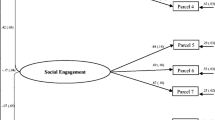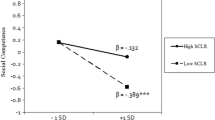Abstract
Because social communication difficulties and stress are common in children with an ASD, and because it has been hypothesised that the two are related, the association between these two variables was investigated in a sample of 90 boys with an ASD and who were aged between 6 years and 12 years of age. The Social Responsiveness Scale (SRS) was completed by the parents of these boys about their sons, plus salivary cortisol samples were collected from the boys. Results indicated that only one aspect of the boys' SRS was significantly correlated with cortisol—Social Motivation (SM). Factor analyses revealed two discrete aspects of SM and each showed different patterns of correlations with cortisol across the seven years of primary school. These results suggest that it was the change in social and teaching expectations that contributed to the variability in SM-cortisol correlations rather than the social expectations per se.


Similar content being viewed by others
References
APA (2000). Diagnostic and statistical manual of mental disorders (4th ed, text revision). Washington, DC: American Psychiatric Association.
APA (2013). Diagnostic and statistical manual of mental disorders-5. Washington, DC: American Psychiatric Association.
Bellini, S. (2004). Social skills deficits and anxiety in high-functioning adolescents with autism spectrum disorder. Focus on Autism and Other Developmental Disabilities, 19, 78–88.
Bellini, S. (2006). The development of social anxiety in adolescents with autism spectrum disorders. Focus on Autism and Other Developmental Disorders, 21, 138–145.
Bitsika, V., Sharpley, C., Andronicos, N., & Agnew, L. (2015). A test of the ‘parent distortion’ hypothesis when assessing generalised anxiety disorder in boys with an autism spectrum disorder. Research in Autism Spectrum Disorders, 15-16, 42–52.
CDC (2015). Child Development. http://www.cdc.gov/ncbddd/childdevelopment/positiveparenting/adolescence2.html. Accessed May 16 2015 2015.
Cohen, J. (1988). Statistical power for the behavioural sciences. Hillsdale, NJ: Erlbaun.
Constantino, J., & Gruber, C. (2005). Social responsiveness scale. Los Angeles, USA: Psychological Services.
Constantino, J., & Gruber, C. (2012). Social responsiveness scale (SRS). Los Angeles, CA: Western Psychological Services.
Corbett, B., Mendoza, S., Abdullah, M., Wegelin, J., & Levine, S. (2006). Cortisol circadian rhythms and response to stress in children with autism. Psychoneuroendocrinology, 31, 59–66.
Corbett, B., Mendoza, S., Wegelin, J., Carmean, V., & Levine, S. (2008). Variable cortisol circadian rhythms in children with autism and anticipatory stress. Journal of Psychiatry and Neuroscience, 33, 227–234.
Corbett, B., Schupp, C., Levine, S., & Mendoza, S. (2009). Comparing cortisol, stress, and sensory sensitivity in children with autism. Autism Research, 2, 39–49.
Corbett, B., Schupp, C., & Lanni, K. (2012). Comparing biobehavioral profiles across two social stress paradigms in children with and without autism spectrum disorders. Molecular Autism, 3, 13–23.
Danial, J., Lin, C., & Wood, J. (2013). Desensitization. In F. Volkmar (Ed.), Encyclopedia of Autism Spectrum Disorders (pp. 869–875): Springer, New York.
Education, Q. D. O. (2015). Social and emotional learning in Queensland state schools. http://www.pathwaystoresilience.org/files/sel/Guide-to-SEL-in-QLD-schools.pdf. Accessed Oct 19 2015 2015.
Elliott, S., Gresham, F., & Witt, J. (2013). Handbook of behavior therapy in education. New York: springer science & business media.
Gillott, A., Furniss, F., & Walter, A. (2001). Anxiety in high-functioning children with autism. Autism, 5, 277–286.
Groden, J., Cautela, J., Prince, S., & Berryman, J. (1994). The impact of stress and anxiety on individuals with autism and developmental disabilities. In E. Shopler, & G. Mesibov (Eds.), Behavioral issues in autism (pp. 177–194). New York: Springer.
Lai, M.-C., Lombardo, M., Pasco, G., Ruigrok, A., Wheelright, S., Sadek, S., et al. (2011). A behavioral comparison of male and female adults with high-functioning autism spectrum conditions. PloS One, 6, e20835.
Lanni, K., Schup, C., Simon, D., & Corbett, B. (2012). Verbal ability, social stress, and anxiety in children with an autistic disorder. Autism: the International Journal of Research and Practice, 16, 123–128.
Lequia, J., Machalicek, W., & Rispoli, M. (2012). Effects of activity schedules on challenging behavior exhibited in children with autism spectrum disorders: A systematic review. Research in Autism Spectrum Disorders, 6(1), 480–492, doi:http://dx.doi.org/10.1016/j.rasd.2011.07.008.
Lopata, C., Volker, M., Putnam, S., Thomeer, M., & Nida, R. (2008). Effect of social familiarity on salivary cortisol and self-reports of social anxiety and stress in children with high-functioning autism spectrum disorders. Journal of Autism and Developmental Disorders, 38, 1866–1877.
Lord, C., Rutter, M., DiLavore, P., Risi, S., Gotham, K., & Bishop, S. (2012). Autism diagnostic observation schedule, second edition (ADOS-2). Los Angeles, CA: Western Psychological Services.
MacNeil, B., Lopes, V., & Minnes, P. (2009). Anxiety in children and adolescents with autism spectrum disorders. Research in Autism Spectrum Disorders, 3, 1–21.
Minshew, N., Turner, C., & Goldstein, G. (2005). The application of short forms of the Wechsler intelligence scales in adults and children with high functioning autism. Journal of Autism and Developmental Disorders, 35, 45–52.
Muris, P., Steerneman, P., Merkelbach, H., Holdrinet, I., & Meesters, C. (1998). Comorbid anxiety symptoms in children with pervasive developmental disorders. Journal of Anxiety Disorders, 12, 387–393.
Queensland, E. (2014). The Queensland School System. https://www.qld.gov.au/education/international/qualifications/school/pages/system.html. Accessed Oxt 19 2015.
Sharpley, C., Bitsika, V., Agnew, L., & Andronicos, N. (2015). Eight-month test-retest agreement in morning salivary cortisol, self- and parent-rated anxiety in boys with an autism spectrum disorder. Physiology & Behavior, 151, 207–212.
Tabachnick, B., & Fidell, L. (2007). Using multivariate statistics (5th ed., ). NY: Pearson.
Taylor, J., & Corbett, B. (2014). A review of rhythm and responsiveness of cortisol in individuals with autism disorders. Psychoneuroendocrinology, 49, 207–228.
van Steensel, F., Bogels, S., & Perrin, S. (2011). Anxiety disorders in children and adolescents with autistic spectrum disorders: a meta-analysis. Clinical Child and Family Psychology Review, 14, 302–317.
Warlaumont, A., Richards, J., Gilkerson, J., & Oller, D. (2014). A social feedback loop for speech development and its reduction in autism. Psychological Science, 25(7), 1314–1324. doi:10.1177/0956797614531023.
White, S. W., Oswald, D., Ollendick, T., & Scahill, L. (2009). Anxiety in children and adolescents with autism spectrum disorders. Clinical Psychology Review, 29(3), 216–229. doi:10.1016/j.cpr.2009.01.003.
Author information
Authors and Affiliations
Corresponding author
Ethics declarations
Ethical Approval
All procedures performed in studies involving human participants were in accordance with the ethical standards of the institutional and/or national research committee and with the 1964 Helsinki declaration and its later amendments or comparable ethical standards.
Informed Consent
Informed consent was obtained from all individual participants included in the study.
Conflict of Interest
Author VB declares no conflict of interest.
Author CFS declares no conflict of interest.
Author LLA declares no conflict of interest.
Author NMA declares no conflict of interest.
Additional information
Vicki Bitsika and Christopher F. Sharpley share senior authorship
Rights and permissions
About this article
Cite this article
Bitsika, V., Sharpley, C.F., Agnew, L.L. et al. Social Motivation is Associated with Elevated Salivary Cortisol in Boys with an ASD. J Dev Phys Disabil 27, 811–822 (2015). https://doi.org/10.1007/s10882-015-9457-x
Published:
Issue Date:
DOI: https://doi.org/10.1007/s10882-015-9457-x




